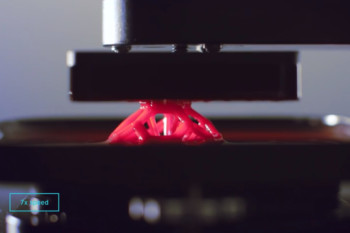A few years back it looked as though 3D printing was set to take off. For those who were new to the tech the possibilities seemed endless. And then they didn’t.
Soon the 3D printing landscape was littered with a slew of FDM printers that simply parroted one another’s abilities. Within no time the consumer 3D printing market went from boom to bust.
Once again, corporate R&D labs and service bureaus were left alone in the additive landscape. Or so it seemed.
Hidden behind much of the consumer hype, a resurgence in additive manufacturing innovation has been taking place. New systems that employ novel engineering and chemistry are quickly transforming additive manufacturing into a technology that can compete with (and in some cases is superior to) conventional manufacturing.
The CLIP System
Of all of the systems in this review, the Continuous Liquid Interface Production—or CLIP system—has garnered the most wide-spread attention. At a TEDTalk in early 2015, Joseph DeSimone, a co-author of the CLIP patent, demonstrated how his machine could print complex models up to 100 times faster than current stereolithography (SLA) technology.
According to its inventors, the CLIP technology works by shining a beam of precisely directed, ultraviolet light onto the base of a resin tray above the light source. Once the resin in the tray is exposed to UV light it cures.
Sounds familiar, right?
What separates CLIP from SLA is that between the base of the tray and the resin pool there’s a “tens-of-microns” thick layer of oxygen. That oxygen boundary keeps the resin pool at bay and allows the light source to project its curing waves beyond the resin tray base. In essence, the CLIP system removes the peeling process that occurs after each layer is cured in traditional SLA processes. That means that CLIP systems can continuously “grow” parts rather than stopping between layers. Hence the massive increases in build speed.
So what’s the catch?
Although CLIP is fast, it’s still an SLA technology. That means that until some chemistry breakthrough occurs, an SLA is only going to be able to build parts from one material at a time. Though for many applications that is fine. In fact, DeSimone believes that CLIP will be able to blow SLA’s material portfolio wide open (think hydrogels, bio-absorbable resins, silicones, etc.). So while it may be just a single material system, CLIP’s speed could make it a mass-manufacturing marvel as well as an engine for real-time mass-customization.
HP’s Mystery Machine
Late in 2013 Hewlett Packard announced it would be entering the 3D printing market with a new technology that would change the way people think about 3D printing. Fast forward 18-months and HP is still teasing its Multi Jet Fusion technology, though in recent months the printing giant has at least advertised how their system works.
To begin a print the Multi Jet system deposits a thin layer of powdered material on the print bed, after which an inkjet head containing some 30,000 nozzles douses the material in chemical agent.
With a chemical additive in the mix, a number of different properties can be bestowed upon the print material, depending on the interplay between material and agent properties. That’s HP’s secret sauce (not HP sauce), and what makes this technology both intriguing and expandable.
Getting back to the print process, with an agent—or possibly agents—in place the powder and chemical are fused together using an as-of-yet unknown energy source. That process repeats until a build is complete.
In a performance presentation held at the Inside 3D Printing conference earlier this year, HP’s J. Scott Schiller wowed the audience with one stat in particular. Over the course of 38 hours HP’s engineers pitted their machine against leading FDM and laser sintering technologies to see how many identical gears they could produce. Once time had elapsed the tally looked like this: FDM 460; SLA 1000; Multi Jet 12,600.
That’s fast.
HP expects their first Multi Jet to hit the market in 2016. If what I was told at AMUG is correct it will only be capable of printing Black Nylon 12 material at first. Sometime later HP’s machine will gain greater capabilities (maybe a firmware tweak?) adding full color (which it can already produce, but won’t be in the first edition) and possibly the ability to print models in ceramic, medical grade materials and even materials with multiple material properties—such as conductivity and elasticity.
When those improvements will come to be is still a mystery. If HP can live up to their forecasts, however, Multi Jet Fusion might provide a very interesting manufacturing solution.
Read more at ENGINEERING.com


